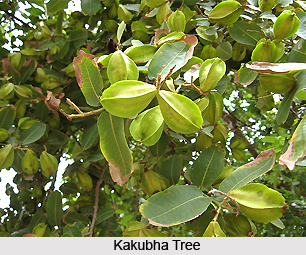 Kakubha is one of the major Indian plants with distinctive medicinal properties. Terminalia arjuna is its scientific name and it grows in abundance along the rivers, streams, ravines as well as in dry watercourses in grassland and forested areas. In Bengali this Indian medicinal Plant is known by various names as arjhan or arjun. In English it is called arjun or white murdah, in Gujarati, Kakubha is commonly known as arjunasadara, dhaulasadr or sadado; arjun, arjuna, kahu, koha or kohwa in Hindi, bilumoddi-nirmathi, holamatti, maddi or thosamatti in Kannada; arjun, holematti or nadiain in Konkani; attumarutu, kattukadukka, nir-maruthu, vellamarutu or vellilaya in Malayalam; in Marathi, it is known as anjan, arjuna, anmadat, sadaru, savimadat or vellamarda; arjuna, arjuno, kaha, khaua, pandasahajo or porjonyasahajo in Oriya; arjan, jumla; Sanskrit: arjuna, arjunah, kakubha, kukubha in Punjabi; kola-marutha, marudu, nirmatti, vellaimaruthu, vellamatta, vellamonda in Tamil. In Telugu, it is called erumaddi, tellamaddi, tittumaddi, yermaddi or yerra-maddi and arjan in Urdu.
Kakubha is one of the major Indian plants with distinctive medicinal properties. Terminalia arjuna is its scientific name and it grows in abundance along the rivers, streams, ravines as well as in dry watercourses in grassland and forested areas. In Bengali this Indian medicinal Plant is known by various names as arjhan or arjun. In English it is called arjun or white murdah, in Gujarati, Kakubha is commonly known as arjunasadara, dhaulasadr or sadado; arjun, arjuna, kahu, koha or kohwa in Hindi, bilumoddi-nirmathi, holamatti, maddi or thosamatti in Kannada; arjun, holematti or nadiain in Konkani; attumarutu, kattukadukka, nir-maruthu, vellamarutu or vellilaya in Malayalam; in Marathi, it is known as anjan, arjuna, anmadat, sadaru, savimadat or vellamarda; arjuna, arjuno, kaha, khaua, pandasahajo or porjonyasahajo in Oriya; arjan, jumla; Sanskrit: arjuna, arjunah, kakubha, kukubha in Punjabi; kola-marutha, marudu, nirmatti, vellaimaruthu, vellamatta, vellamonda in Tamil. In Telugu, it is called erumaddi, tellamaddi, tittumaddi, yermaddi or yerra-maddi and arjan in Urdu.
Kakubha is usually an evergreen tree which is about 15 to 25 meters tall. This medicinal plant grows with a spreading crown and drooping branches. It is buttressed and is often found available with fluted stem. This Indian medicinal plant, Kakubha has very thick bark and is offered with grey or pinkish-green colour. The barks are smooth and when peeled off come in large, thin irregular sheets. The young twigs of the plant are presented as smooth or with yellowish-brown hairs. In the Kakubha plant the leaves generally grow in the sub-opposite direction. They are found to be in elliptic-lanceolate or elliptic-oblong shape. The leaves are further coriaceous, pale dull green in the above and pale brown beneath. Kakubha has leaves that are about 7.5 to 17.5 centimeters long and 2.5 to 5.5 centimeters wide. At the apex, these leaves are shortly acute or obtusely acuminate and rounded or cuneate at the base. Margins of the leaves are slightly crenate-serrate. There are 12 to 18 pairs of main nerves. The petiole is within 3 to 10 millimeter long and usually with 1 to 2 prominent glands at the top and below the leaf blade.
Flowers of the Kakubha are sessile and come in yellowish-white colour. They bear short axillary spikes or terminal panicles with 9 to 13 centimeters long. Bracteoles of the Kakubha are linear-lanceolate but shorter than the flowers and caduceus. This medicinal plant has calyx glabrous and triangular teeth. Kakubha provide ovoid-oblong shape fruits. They are within 3 to 6 centimeter long and 1.8 to 2.8 centimeter wide. These fruits are nearly glabrous and are available with 5 to 7 hard and winged angles. This Indian medicinal plant is usually notched at top. In central India, flowering occurs between April and June and the fruits start maturing from the following February and continues till April. In dry habitats between March and May, this medicinal plant is occasionally found to be leafless for a short period.
Kakubha is an essential plant having unique medicinal properties and uses. The bark of this plant is acrid and sweet and is credited with medicinal properties such as alexiteric, styptic, tonic, febrifugal and antidysenteric. The bark of this plant also finds its importance in Ayurveda. It is used in the treatment of polyuria, cardiac diseases, blood diseases, chronic fever, fractures, obesity and skin diseases.
Kakubha is also used by the Siddha and in this practice the whole plant is considered to include medicinal properties. The bark, leaf and fruit of the Kakubha tree are used for treating diabetes mel-litus, leucorrhoea, cardiac diseases, leprosy, worm infestation, abdominal disorders and ulcers. The powdered bark reportedly gives relief in cases of symptomatic hypertension and acts as a diuretic and general tonic in cases of cirrhosis of the liver. The powdered bark when taken with milk, is used to treat bone fractures and contusions. Among the tribal inhabitants of Surguja District in northeastern Madhya Pradesh, the powdered bark is taken with water for treating gastric troubles, and the juice of the leaves or bark is prescribed for treating high blood pressure. A decoction of the bark is used as a wash for ulcers and taken internally as a febrifuge. Ashes of the bark are also useful as sometimes they are prescribed to treat scorpion sting. The fruit of this Indian medicinal plant is used as tonic and de-obstruent. Moreover, the juice of the fresh leaves from Kakubha is used to treat earache.



















